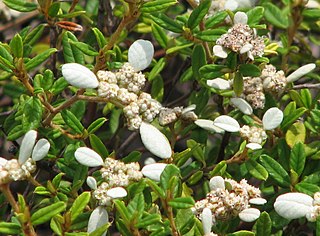
Spyridium vexilliferum, commonly known as winged spyridium, or helicopter bush, is a species of flowering plant in the family Rhamnaceae and is endemic to south-eastern Australia. It is a small, low-lying to erect shrub with linear to narrowly elliptic leaves, and dense heads of small white flowers.

Lasiopetalum maxwellii is a species of flowering plant in the family Malvaceae and is endemic to the south coast Western Australia. It is a sprawling shrub with hairy young stems, lance-shaped to oblong leaves and white to cream-coloured flowers.

Lasiopetalum behrii, commonly known as the pink velvet bush, is a species of flowering plant in the family Malvaceae and is endemic to southern continental Australia. It is an erect shrub with lance-shaped, narrowly oblong to narrowly elliptic leaves and groups of white to pink and reddish-brown flowers.

Lasiopetalum ferrugineum, commonly known as rusty velvet-bush, is a species of flowering plant in the mallow family and is endemic to eastern Australia. Growing up to a metre tall, much of the plant is covered in rusty hairs. It is found in forest and heathland.

Lasiopetalum macrophyllum, commonly known as shrubby velvet bush, is a species of flowering plant in the family Malvaceae and is endemic to south-eastern Australia. It is a shrub with egg-shaped to lance-shaped with rust-coloured hairs on the lower surface, and woolly-hairy, cream-coloured and reddish flowers.
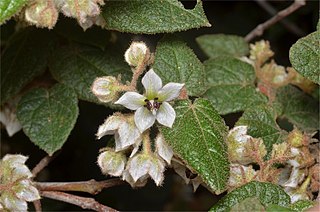
Lasiopetalum schulzenii, commonly known as drooping velvet-bush, is a species of flowering plant in the family Malvaceae and is endemic to southern continental Australia. It is a shrub with heart-shaped leaves and small groups of hairy white and reddish-brown flowers.

Lasiopetalum baueri, commonly known as slender velvet bush, is a species of flowering plant in the family Malvaceae and is endemic to south-eastern Australia. It is a small, greyish shrub with more or less linear to narrowly oblong or narrowly elliptic leaves and groups of white or pink flowers.
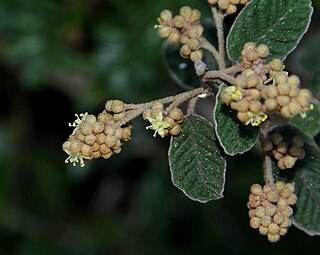
Pomaderris oraria, commonly known as Bassian dogwood, is a species of flowering plant in the family Rhamnaceae and is endemic to south-eastern Australia. It is a compact shrub with hairy branchlets, hairy, elliptic leaves and panicles of hairy, greenish to cream-coloured or crimson-tinged flowers.

Styphelia ericoides, commonly known as the pink beard-heath, is a species of flowering plant in the heath family Ericaceae and is endemic to south-eastern Australia. It is a slender shrub with oblong leaves, and white to pinkish, tube-shaped flowers.

Lasiopetalum rufum is a species of flowering plant in the family Malvaceae and is endemic to the Sydney region of New South Wales. It is a slender, erect or diffuse shrub with linear leaves and small groups of reddish or pinkish flowers.

Philotheca virgata, commonly known as Tasmanian wax-flower, is a species of flowering plant in the family Rutaceae and is endemic to south-eastern Australia. It is a slender, erect shrub with wedge-shaped to oblong leaves and white or pale pink flowers at the ends of branchlets. It is the only philotheca with four sepals and petals.
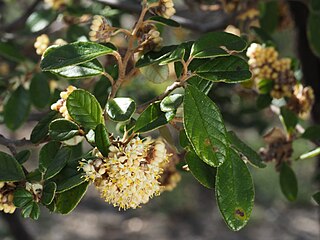
Pomaderris betulina, commonly known as birch pomaderris, is a species of flowering plant in the family Rhamnaceae and is endemic to south-eastern continental Australia. It is a shrub with hairy young stems, lance-shaped to oblong or elliptic leaves, and yellowish flowers.
Lasiopetalum compactum, is a species of flowering plant in the family Malvaceae and is endemic to the south-west of Western Australia. It is an erect shrub with leathery, narrowly oblong leaves and cymes of white to pinkish flowers.

Lasiopetalum drummondii is a species of flowering plant in the family Malvaceae and is endemic to the south-west of Western Australia. It is an erect, slender shrub with many densely hairy stems, egg-shaped or oblong leaves and white, pink and red flowers.
Lasiopetalum fitzgibbonii is a species of flowering plant in the family Malvaceae and is endemic to the south-west of Western Australia. It is an erect, spreading shrub with hairy stems, needle-shaped leaves and blue, purple or pink flowers.
Lasiopetalum longistamineum is a species of flowering plant in the family Malvaceae and is endemic to a restricted area of New South Wales. It is a spreading shrub with its branches densely covered with woolly, rust-coloured hairs and has egg-shaped leaves and woolly-hairy flowers.
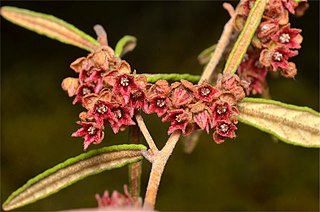
Lasiopetalum micranthum is a species of flowering plant in the family Malvaceae and is endemic to a small region of eastern Tasmania. It is a low, spreading shrub with thin, rusty-hairy branches, narrow oblong leaves and drooping, star-shaped red to greyish-pink or white flowers.

Lasiopetalum parviflorum is a species of flowering plant in the family Malvaceae and is endemic to south-eastern continental Australia. It is a shrub with rusty-hairy stems, more or less glabrous leaves with the edges rolled under, and greenish to cream-coloured flowers.
Lasiopetalum × tepperi is a species of flowering plant in the family Malvaceae and is endemic to the south-east of South Australia. It is an erect, spreading or sprawling shrub with hairy stems, egg-shaped to lance-shaped leaves and pink flowers.
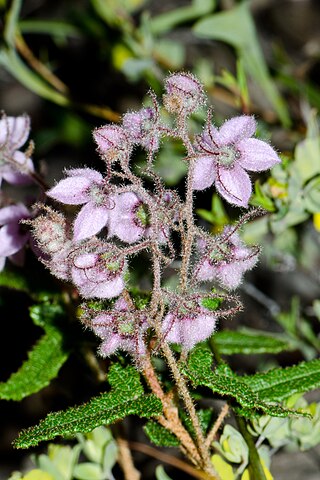
Lasiopetalum venustum is a species of flowering plant in the family Malvaceae and is endemic to a restricted area in the south-west of Western Australia. It is an erect shrub with hairy stems, egg-shaped, three-lobed leaves and pink and dark red flowers.

















